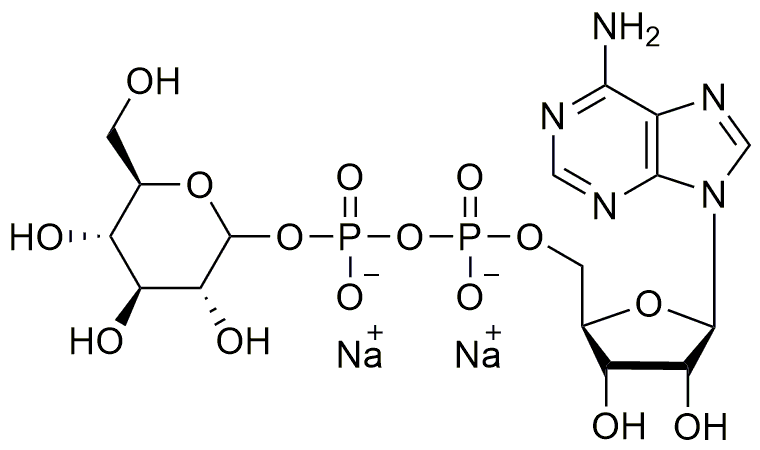Adenosine-5'-diphosphoglucose disodium salt is widely utilized in research focused on:
- Biochemical Research: This compound serves as a crucial substrate in enzymatic reactions, particularly in studies involving glycogen synthesis and metabolism, helping researchers understand energy storage mechanisms in cells.
- Pharmaceutical Development: It is used in the formulation of drugs aimed at enhancing cellular energy levels, which can be beneficial in treating conditions like muscle fatigue or metabolic disorders.
- Cell Culture Applications: The compound is often added to cell culture media to promote cell growth and viability, making it essential for studies in tissue engineering and regenerative medicine.
- Metabolic Studies: Researchers utilize it to investigate metabolic pathways and energy transfer processes, providing insights into diseases such as diabetes and obesity.
- Analytical Chemistry: It is employed as a standard in various assays to quantify enzyme activity related to glucose metabolism, aiding in the development of diagnostic tools.
Información general
Propiedades
Seguridad y normativas
Aplicaciones
Adenosine-5'-diphosphoglucose disodium salt is widely utilized in research focused on:
- Biochemical Research: This compound serves as a crucial substrate in enzymatic reactions, particularly in studies involving glycogen synthesis and metabolism, helping researchers understand energy storage mechanisms in cells.
- Pharmaceutical Development: It is used in the formulation of drugs aimed at enhancing cellular energy levels, which can be beneficial in treating conditions like muscle fatigue or metabolic disorders.
- Cell Culture Applications: The compound is often added to cell culture media to promote cell growth and viability, making it essential for studies in tissue engineering and regenerative medicine.
- Metabolic Studies: Researchers utilize it to investigate metabolic pathways and energy transfer processes, providing insights into diseases such as diabetes and obesity.
- Analytical Chemistry: It is employed as a standard in various assays to quantify enzyme activity related to glucose metabolism, aiding in the development of diagnostic tools.
Documentos
Hojas de datos de seguridad (HDS)
La SDS proporciona información de seguridad completa sobre la manipulación, el almacenamiento y la eliminación del producto.
Especificación del producto (PS)
La PS proporciona un desglose completo de las propiedades del producto, incluida la composición química, el estado físico, la pureza y los requisitos de almacenamiento. También detalla los rangos de calidad aceptables y las aplicaciones previstas del producto.
Certificados de análisis (COA)
Busque certificados de análisis (COA) ingresando el número de lote del producto. Los números de lote y de partida se pueden encontrar en la etiqueta de un producto después de las palabras "Lote" o "Lote".
Número de catálogo
Número de lote/lote
Certificados de origen (COO)
Este certificado de origen confirma el país en el que se fabricó el producto y también detalla los materiales y componentes utilizados en él y si se deriva de fuentes naturales, sintéticas u otras fuentes específicas. Este certificado puede ser necesario para cumplir con las normativas aduaneras, comerciales y regulatorias.
Número de catálogo
Número de lote/lote
Hojas de datos de seguridad (HDS)
La SDS proporciona información de seguridad completa sobre la manipulación, el almacenamiento y la eliminación del producto.
DownloadEspecificación del producto (PS)
La PS proporciona un desglose completo de las propiedades del producto, incluida la composición química, el estado físico, la pureza y los requisitos de almacenamiento. También detalla los rangos de calidad aceptables y las aplicaciones previstas del producto.
DownloadCertificados de análisis (COA)
Busque certificados de análisis (COA) ingresando el número de lote del producto. Los números de lote y de partida se pueden encontrar en la etiqueta de un producto después de las palabras "Lote" o "Lote".
Número de catálogo
Número de lote/lote
Certificados de origen (COO)
Este certificado de origen confirma el país en el que se fabricó el producto y también detalla los materiales y componentes utilizados en él y si se deriva de fuentes naturales, sintéticas u otras fuentes específicas. Este certificado puede ser necesario para cumplir con las normativas aduaneras, comerciales y regulatorias.


